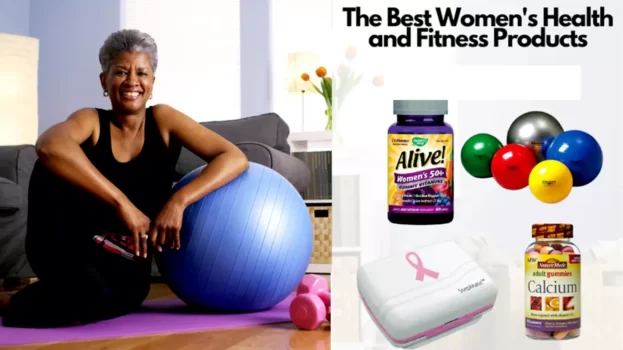Views: 6
Women’s Health and Fitness Day in September encourages women to attend to their individual health needs and take steps to improve their overall health. Read on to learn about some of the major issues in women’s health and how to get active to prevent them!
Women’s Health and Fitness Day 2022: 6 Ways to Support Women’s Health & Fitness
September 29, 2022 Joel La Puma
From:


1. Learn About Issues in Women’s Health
The body is always complex, but women have a host of health conditions that are either exclusive or disproportionately experienced by them. It can be difficult to find doctors who specialize in or even have adequate experience with many of these conditions. In addition, medical science has often been developed with male physiology in mind. This is an issue because women and men may have very different symptoms for the same conditions, or different responses to the same treatments. Diagnostic periods for women tend to take longer, and this is one reason why.
Conditions Exclusive to Women
- Gynecological Issues: Endometriosis, Polycystic Ovary Syndrome (PCOS), menstrual irregularity, bacterial vaginosis, uterine fybroids, and others.

- Pregnancy Issues: Preconception and prenatal care, pregnancy loss, preterm labor and premature birth, and others.
- Fertility Issues: Primary ovarian insufficiency, as well as many above conditions.
- Ovarian and Cervical Cancers

- Menopause
- Turner Syndrome
- Rett Syndrome
Conditions More Likely to Affect Women
- Bone Health: Osteoarthritis and Osteoporosis
- Pelvic Floor Disorders: Pelvic organ prolapse, urinary or fecal incontinence.
- Urinary Tract Disorders and Infections
- Thyroid Disorders: Hypothyroidism, hyperthyroidism, thyroiditis, goiter.
- Thyroid Cancer
- Breast Cancer

- Many Chronic Pain Disorders: Fibromyalgia and chronic fatigue syndrome.
- Depression and Anxiety Disorders
- Domestic or Sexual Violence
A litany of studies suggest that women, unfortunately, have more trouble than men finding adequate care. They spend longer in diagnostic periods, have longer hospital waits, and are more likely to have their conditions misdiagnosed or their symptoms of pain downplayed or ignored. Female-specific conditions often receive less research attention and funding, and women are more likely to have “medically unexplained” symptoms — subjective symptoms (pain, dizziness, lightheadedness) that aren’t immediately connected to a specific physical cause. It’s important for women to educate themselves about conditions that they’re more likely to experience, as a strong knowledge base will help you advocate for your own care as a patient.
2. Schedule a Checkup
National Women’s Fitness and Health Day is the perfect opportunity to schedule a checkup with a medical professional! You may want to consider a Well-Woman Visit, a physical and in-depth discussion about your health, tailored to your age and family history, with special attention paid to problems that largely or exclusively affect women. You also may want to visit your gynecologist, or schedule a prenatal visit if pregnant.
In addition, to honor the day many organizations will be providing free screenings for women’s health issues. Here are some to look for:
- Mammograms
- Pap smears for cervical cancer
- Thyroid function tests
- STD screenings
- Bone-mass measurements
- Cholesterol: heart disease is the number one killer of women.


3. Exercise
A major component of women’s health is staying active and exercising regularly. Whether you’re doing cardio or strength training, going to the gym or playing a sport, regular exercise gives many health benefits, some of which are specific to women’s health:
- Mood Stabilization: releasing endorphins to reduce anxiety and depression, and counter the estrogen drop before and after a period.
- Strengthening Bones: 80% of Americans with osteoporosis are women, and 50% of women with it will break a bone.
- Weight Loss
- Improving Sleep: hormone fluctuations during the menstrual cycle, as well as pregnancy, can adversely affect sleep.
4. Manage Your Diet
Women have specific dietary needs that may change over the course of their lives and can differ from what men might need. Nutrients of particular relevance to women’s health include:
- Iron: 20% of women and 50% of pregnant women don’t have enough iron, which helps prevent anemia and produce oxygen-carrying hemoglobin.
- Folic Acid: This form of Vitamin B9 decreases the risk of birth defects.
- Calcium and Vitamin D: These strengthen bones and teeth, making them vital in preventing loss of bone mass and diseases like osteoporosis.


Have a Conversation
If National Women’s Fitness and Health Day has one thing to teach us, it’s that coming together to discuss women’s health is vital in maintaining it. Social support is invaluable in maintaining exercise regimens, improving moods, reducing stress, and better understanding our own health and fitness needs.
5. Share Your Health
Involve Your Loved Ones
Studies have shown that people who have a regular exercise companion generally have an easier time staying motivated and sticking to a regular schedule, and consequently lose more weight. Whether you’re working out with a friend or family member, mutual support is one of the most effective factors behind getting and staying in shape.
Prioritize Mental Health
Stress levels contribute to declines in physical health, and women consistently report higher rates of stress than men as well as more emotional and physical symptoms resulting from stress.
Some ways to manage stress include:
- Exercise: the endorphins created by exercise are great at relieving stress
- Sleeping: ensure you get enough sleep.
- Massage
- Relaxation Techniques: deep breathing, meditation, yoga, or tai chi.
- Set Limits on Responsibilities: learn to say no to excessive responsibilities.
- Social Support: seek out support, whether through loved ones or support groups.
- Mental Health Support: seek out treatment from a mental health professional.
Women are also more likely to suffer from depression and anxiety disorders, with twice the number of women than man experiencing depression. Sometimes this occurs due to physical factors, such as menopause and premenstrual syndrome, which effects 20-40% of women, with 3-5% having symptoms strong enough to be classified as Premenstrual Dysphoric Disorder (PMDD). 10-15% of women experience postpartum depression, as well.
Depression is misdiagnosed in women 30-50% of the time, and fewer than half the women suffering it will seek care. If you think you may have symptoms associated with anxiety or depression, don’t hesitate to seek out professional help!
6. Visit Mountainside Medical Equipment for the Best Women’s Health and Fitness Products
Ensuring you’re at your healthiest involves many different aspects of health: the right diet and nutrients, adequate rest, regular exercise, and the right medications to manage ongoing conditions. Luckily Mountainside Medical Equipment has you covered! We’ve got everything from bone & joint health supplements to topical pain gels to get you active and help you stay healthy. Click this link to visit our women’s health products!

Please consult your doctor or other qualified medical professional before stopping or starting any medications, supplements, or health regimens.






